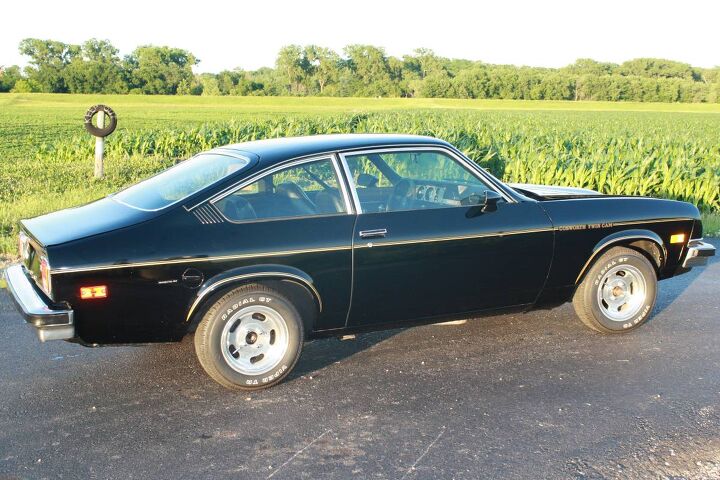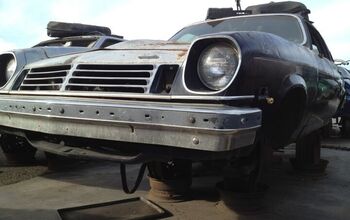Rare Rides: This 1975 Chevrolet Is Both Vega and Cosworth

An enterprising GM executive, a British tuning company, and a compact hatchback came together in 1975 to make a very special, limited-production Chevrolet.
It’s the Cosworth Vega, naturally.
This Vega is the third instance of an H-body vehicle in the Rare Rides series; the only time we’ve featured a single platform thricely.
Chevrolet’s Vega was the first vehicle on General Motors’ H-body. Hitting dealer lots back in 1971, the Vega was available in two-door sedan, hatchback, wagon, and sedan delivery variants. As it stood on dealer lots, the Vega was very much a middle market car, with middle market performance. None of this was very interesting to GM vice president John DeLorean, so he sent an engineer over to England to scout around for a way to add some sportiness to the Vega. The engineer in question ended up visiting with Cosworth, who designed a twin-cam cylinder head that worked with the existing Vega engine.
Throughout its run, two different variations of inline-four engines powered standard Vega models — both of them 2.3-liters in displacement. This engine was reworked considerably for Cosworth Vega duty, shrinking down to 2.0 liters, and paired with the aforementioned Cosworth cylinder head. But the project was a low priority among GM management, and DeLorean had an uphill battle to get corporate approval. With the engine ready in early 1971, DeLorean brought the project to GM’s president, Edward Cole.
DeLorean pitched the idea by preparing three performance Vegas for Mr. Cole to sample. One was a base model, the second had a small-block V8 under hood, and the third was the Cosworth. Cole was duly impressed by the tuned four cylinder, and offered his approval. Cosworth was go.
Chevy prepared a number of test cars to comply with EPA testing standards. More than one rework of the engine was required, as well as further test car examples to prepare for revised EPA regulations starting in 1975. The ’75 regulations required a revised electronic ignition, the addition of a catalytic converter, and a rework of the fuel injection system.
As 1975 rolled around, the Cosworth passed all tests and began production with its 140-horsepower engine. Assembled at the Lordstown, Ohio plant which would later make Cruzes, all 1975 models shared the same black and gold theme. 1976 saw a cosmetic update and the addition of several different paint color options. Though the car magazines were all impressed, the asking price for a Cosworth Vega was just $900 less than a Corvette in the same showroom. Ouch. All told, Chevy made just 3,508 Cosworth Vegas.
Located in Kansas City, today’s example comes complete with a sale ad featuring eleven pages of all-caps text. The miles are 2,948 and the asking price is $20,000.
[Images: seller]

Interested in lots of cars and their various historical contexts. Started writing articles for TTAC in late 2016, when my first posts were QOTDs. From there I started a few new series like Rare Rides, Buy/Drive/Burn, Abandoned History, and most recently Rare Rides Icons. Operating from a home base in Cincinnati, Ohio, a relative auto journalist dead zone. Many of my articles are prompted by something I'll see on social media that sparks my interest and causes me to research. Finding articles and information from the early days of the internet and beyond that covers the little details lost to time: trim packages, color and wheel choices, interior fabrics. Beyond those, I'm fascinated by automotive industry experiments, both failures and successes. Lately I've taken an interest in AI, and generating "what if" type images for car models long dead. Reincarnating a modern Toyota Paseo, Lincoln Mark IX, or Isuzu Trooper through a text prompt is fun. Fun to post them on Twitter too, and watch people overreact. To that end, the social media I use most is Twitter, @CoreyLewis86. I also contribute pieces for Forbes Wheels and Forbes Home.
More by Corey Lewis
Latest Car Reviews
Read moreLatest Product Reviews
Read moreRecent Comments
- Brendan Duddy soon we'll see lawyers advertising big payout$ after getting injured by a 'rogue' vehicle
- Zerofoo @VoGhost - The earth is in a 12,000 year long warming cycle. Before that most of North America was covered by a glacier 2 miles thick in some places. Where did that glacier go? Industrial CO2 emissions didn't cause the melt. Climate change frauds have done a masterful job correlating .04% of our atmosphere with a 12,000 year warming trend and then blaming human industrial activity for something that long predates those human activities. Human caused climate change is a lie.
- Probert They already have hybrids, but these won't ever be them as they are built on the modular E-GMP skateboard.
- Justin You guys still looking for that sportbak? I just saw one on the Facebook marketplace in Arizona
- 28-Cars-Later I cannot remember what happens now, but there are whiteblocks in this period which develop a "tick" like sound which indicates they are toast (maybe head gasket?). Ten or so years ago I looked at an '03 or '04 S60 (I forget why) and I brought my Volvo indy along to tell me if it was worth my time - it ticked and that's when I learned this. This XC90 is probably worth about $300 as it sits, not kidding, and it will cost you conservatively $2500 for an engine swap (all the ones I see on car-part.com have north of 130K miles starting at $1,100 and that's not including freight to a shop, shop labor, other internals to do such as timing belt while engine out etc).








































Comments
Join the conversation
All Vegas had the aluminum engine, no iron sleeves. Reliability was improved by enlarging the radiator to minimize overheating. Pontiac & Olds versions, and Monzas after 77, had iron Pontiac engines, "Iron Duke", related to the 4 cylinder engine used in Chevy IIs.
My father bought a '74 Vega GT, and I got my license in the spring of '79. That damn Vega didn't last long enough for me to drive the thing, our wonderful Cleveland winters ate that turd up in less than 5 years.